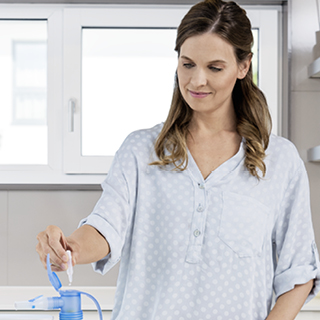
The therapeutic uses of nebuliser therapy are varied and range from the prevention and treatment of colds to the treatment of severe respiratory diseases.
One advantage of inhalation therapy with a PARI nebuliser is that the saline solution or the medication can start working directly at the site of the illness, because it doesn’t have to pass through the stomach. A popular treatment for preventing colds is to inhale an isotonic saline solution, such as the PARI NaCl Inhalation Solution. The indications for inhalation therapy are, however, varied. For example, patients with serious diseases like cystic fibrosis, asthma, COPD, chronic bronchitis and sinusitis can inhale saline solutions and medication solutions specifically prescribed by the doctor.
Have you ever experienced dry vocal cords? Dry vocal cords are an enormous problem, not only for patients with severe respiratory diseases. Teachers, singers, call centre staff, actors and trainers who all have to use their voices extensively at work often have scratchy voices, a dry cough and are more susceptible to colds. Nebuliser therapy with an isotonic saline solution, such as the PARI NaCl Inhalation Solution can help the vocal cords to recover and can prevent diseases. Isotonic saline solutions, also called physiological saline solutions, are designed to match the salt content of our bodily fluids.
Nebulising isotonic and slightly hypertonic (higher salt content) saline solutions can be used even for infants and preschoolers. We all know children get a lot of colds and coughs. Saline solutions soothe your child’s airways, cleanse and calm the mucous membranes and can, depending on the salt content, liquefy mucus and make it easier to expel. If your child has to inhale medications, only very small doses are needed compared to taking tablets, because inhalation therapy acts locally and directly in the bronchial tubes. For the small airways of children, the small aerosol droplets as produced, for example, by the PARI JuniorBOY SX are especially beneficial.
Contact us
Any questions? You can reach us at this number:
01932 341122
© 2025 PARI GmbH Spezialisten für effektive Inhalation